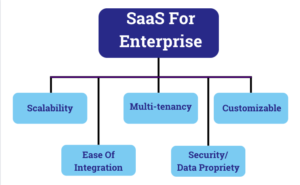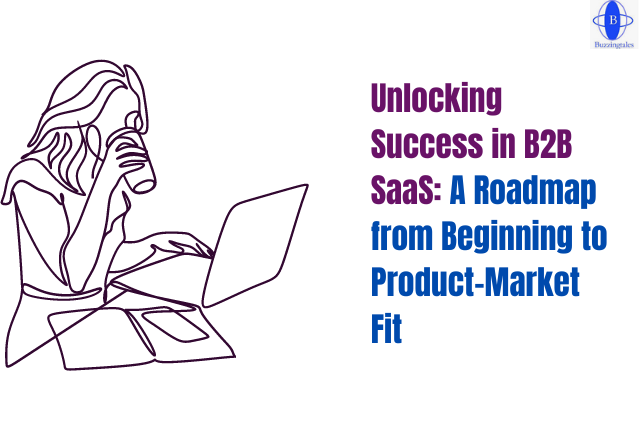Unlocking Success in B2B SaaS: A Roadmap from Beginning to Product-Market Fit
Below is a business writing sample:
In the competitive landscape of B2B SaaS, mastering enterprise sales is not just a skill; it’s necessary for achieving top-tier revenue. No enterprise customers don’t care if you have Gen AI or not; they are want to see if you can help them achieve their business objectives in an effective and cost efficient way. Let’s unveil the essential checklist for founders embarking on the journey from idea conception to cracking the code of enterprise sales. What are the strategic steps essential for success in this lucrative domain? Read on to discover more.
The High Stakes of Enterprise Sales: Crafting Your Winning Strategy
In the realm of enterprise sales, the stakes are high, with substantial Annual Customer Value (ACV) and multi-year deals awaiting those who succeed. However, gaining entry into this elite circle requires more than just a great product—it demands a meticulously crafted strategy from the outset.
Selling to enterprises is akin to charming a princess and beating the competition- a pool of elite suitors worldwide. The question is, do you have that debonair quality in you to woe the princesses? To secure your place among these coveted clients, you must build a product that commands top value from inception.
SaaS enterprise software stands as a remarkably adaptable solution, capable of addressing a myriad of industry-specific challenges. Despite the diverse array of applications and functionalities it offers, a core set of traits unites most SaaS enterprise software platforms.
- Firstly, multi-tenancy lies at the heart of these systems, designed to accommodate multiple users or clients simultaneously, fostering shared access and collaboration.
- Moreover, scalability serves as a foundational principle, ensuring that the software can effortlessly adjust to accommodate organizational growth or contraction, thus aligning seamlessly with evolving business needs.
- Another defining feature is the software’s inherent customizability and configurability. This empowers organizations to tailor the software to their precise requirements, almost akin to bespoke solutions crafted specifically for their unique contexts.
- Security remains paramount in enterprise SaaS applications, with stringent measures such as encryption protocols, access controls, and regular data security updates woven into the fabric of the software to safeguard sensitive information.
- Additionally, comprehensive integration libraries and APIs further enhance the software’s utility, facilitating seamless data exchange and workflow automation across various platforms and interfaces.
While these characteristics are ubiquitous in enterprise software, it’s the nuanced amalgamation and fine-tuning of these functionalities that afford users the ability to craft solutions tailored precisely to their pain points and operational requirements.

Every Player Needs a Playbook
The B2B SaaS Sales Playbook demystifies the labyrinth of B2B sales, providing a comprehensive guide to navigate the intricate journey of closing deals. Unlike its generic counterpart, tailored specifically for businesses engaging in B2B transactions, a playbook accelerates successful sales endeavors.
- Central to the B2B SaaS Sales Playbook is the meticulous delineation of target markets. By identifying and understanding the nuances of the ideal customer persona, businesses can craft strategies attuned to address their specific needs and aspirations.
- At its core, the playbook serves as a repository of sales strategies, meticulously curated to resonate with B2B clientele. It offers a panoramic view of various tactics and approaches, empowering sales professionals to adeptly navigate the intricate landscape of B2B transactions.
- A pivotal aspect of the playbook lies in its ability to distill complex industry landscapes into actionable insights. Through meticulous industry research, businesses gain a profound understanding of prevailing trends, competitive dynamics, and emerging opportunities, thereby equipping themselves to make informed decisions and seize lucrative prospects.
- Furthermore, the playbook facilitates a comparative analysis of competitors, offering invaluable insights into their products, sales strategies, and market positioning. Armed with this knowledge, businesses can devise strategies to differentiate themselves, capitalize on competitive advantages, and carve out a distinct niche in the market.
- Integral to the B2B SaaS Sales Playbook is the delineation of a comprehensive sales process. By providing a step-by-step guide, it empowers sales professionals to navigate each stage of the sales journey with confidence and precision, from prospecting and qualifying leads to negotiating and closing deals.
- Moreover, the playbook offers a comprehensive overview of product information, arming sales professionals with the knowledge and insights needed to effectively communicate the value proposition of their offerings. Through detailed product sheets and data sheets, businesses can articulate the functionality, benefits, and unique selling points of their products or services, thereby compellingly positioning themselves in the market.
- Central to the efficacy of the playbook is the establishment of clear goals and key performance indicators (KPIs). By delineating measurable objectives, businesses can track progress, evaluate performance, and optimize strategies for continued success.
In an era characterized by digital transformation, leveraging B2B sales playbook software emerges as imperative. It offers a centralized platform for pre-planning and executing sales strategies, fostering agility, scalability, and adaptability in an ever-evolving business landscape.
Mastering the creation of a B2B sales playbook framework entails embracing principles of agility and innovation. By analyzing past sales playbooks and revenue patterns, businesses can refine their strategies, enhance pipeline forecasting, and drive sustainable growth.
A B2B SaaS Sales Playbook transcends the realm of mere documentation, serving as a dynamic blueprint for success in the competitive arena of B2B sales. Through its comprehensive insights, actionable strategies, and relentless focus on customer-centricity, it empowers businesses to navigate complexities, seize opportunities, and emerge victorious in the relentless pursuit of sales excellence.
Navigating the Maze: Understanding Market Dynamics and Ideal Customer Personas
Central to success in enterprise sales is a deep understanding of market dynamics and Ideal Customer Personas (ICPs). It’s important to cast a wide net for feedback during the discovery phase, transcending beyond your immediate customer base. Just as in fishing, expanding your reach to include various stakeholders—from venture capitalists to industry peers—can yield valuable insights.
Identifying the right ICP is paramount, as it forms the foundation of your SaaS startup’s success. Whether you’re targeting founders, engineering heads, or developers within enterprises, understanding their preferences and pain points is key to tailoring your approach effectively.
Unveiling Buying Triggers: The Key to Unlocking Enterprise Sales
Success in enterprise sales hinges on identifying and leveraging buying triggers—those magical stimuli that compel decision-makers to say, “Yes, this is what we need!” While some triggers are overt, others require a more nuanced approach. It’s crucial to be discerning, emphasizing the need to prioritize triggers that align with your product offering and capabilities.
From Product-Market Fit to Go-To-Market Strategy: Building Sustainable Scalability
Achieving Product-Market Fit (PMF) is the cornerstone of success in the B2B SaaS space. By aligning your product with the needs and demands of your target market, you lay the groundwork for sustainable scalability. Rishi stresses the importance of differentiating features from the core product, ensuring that each enhancement adds tangible value for the customer.
Crafting an effective Go-To-Market (GTM) strategy is essential for reaching your target audience and driving growth. What works is early investment in inbound marketing efforts, emphasizing the value of authentic, informative content in building trust with your audience. By understanding the distinct triggers of inbound and outbound strategies, you can tailor your approach to resonate with your audience effectively.
Positioning for Success: Articulating Your Differentiator
In the competitive landscape of enterprise sales, clear positioning is essential for standing out from the crowd. Rishi emphasizes the importance of articulating your product’s unique value proposition and understanding your customers’ needs intimately. By creating a website with content tailored to your audience’s preferences, you demonstrate your commitment to their success and become an automated inbound sales engine.
Final Word: The Path to Prosperity
In the journey from inception to product-market fit, diligence, precision, and continuous effort are essential ingredients for success. By understanding your Ideal Customer Personas, identifying key buying triggers, and crafting a tailored Go-To-Market strategy, you can unlock the potential for higher contract value, better customer retention, and sustainable growth in the enterprise sales arena. Embark on this journey with confidence, and the rewards will undoubtedly be worth the effort.

